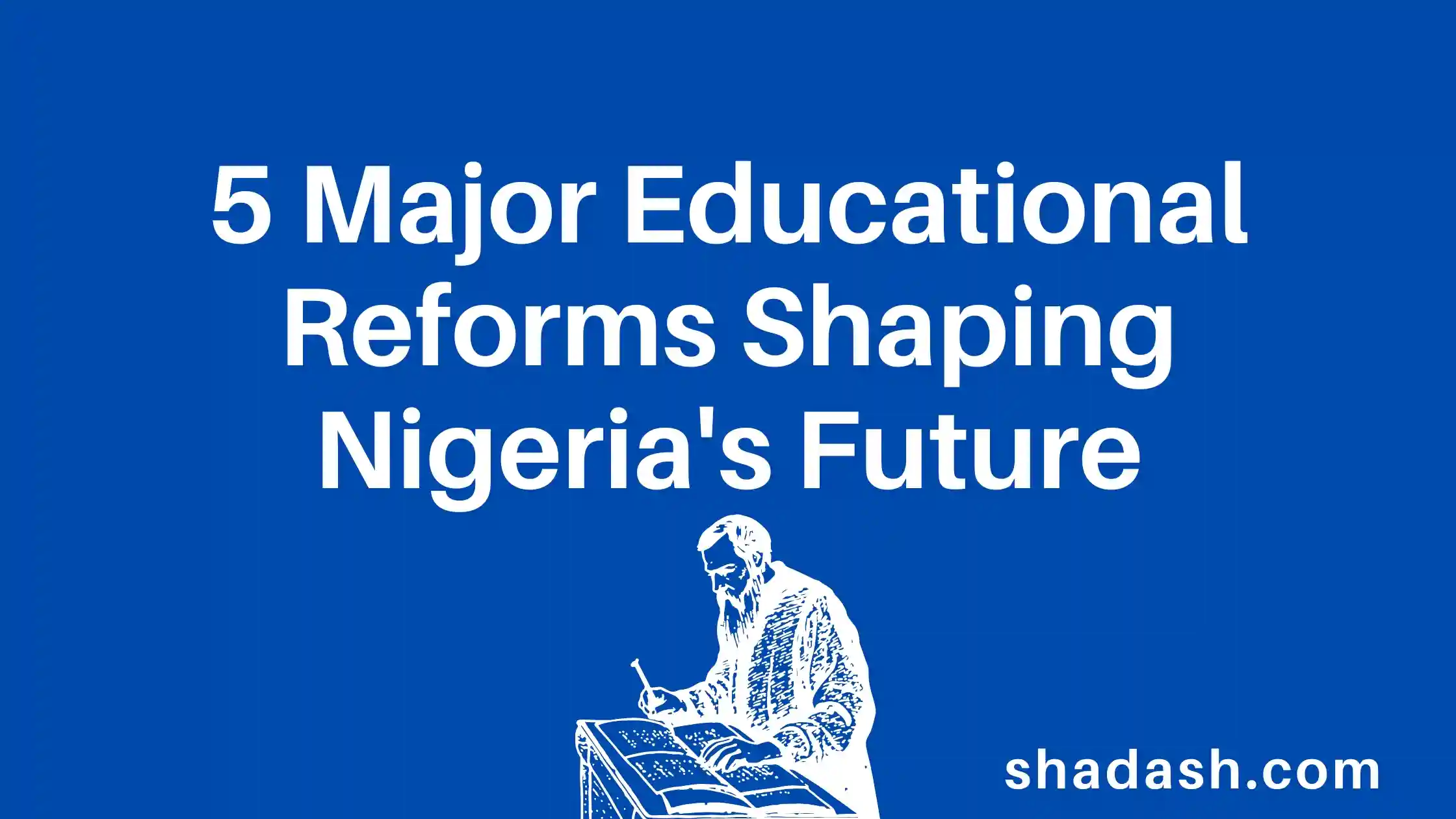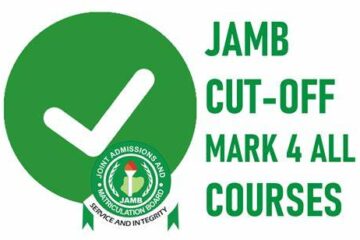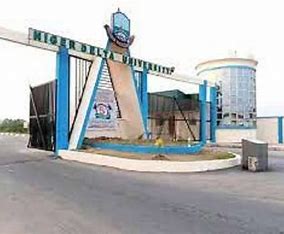Nigeria’s education sector is undergoing significant changes, with five key reforms at the forefront of transforming the country’s learning landscape. These reforms aim to improve access to quality education, enhance curriculum relevance, leverage technology, strengthen teacher training, and promote inclusive education. This article explores these educational reforms in Nigeria and their potential impact on the nation’s future.
Education plays a crucial role in shaping a nation’s future, and Nigeria recognizes this fact. In recent years, the country has embarked on several educational reforms aimed at addressing long-standing challenges and preparing its youth for the demands of the 21st century. Today we will look into five major educational reforms that are currently shaping Nigeria’s future.
Table of Contents
- 1 The 5 Major Educational Reforms Shaping Nigeria’s Future
- 2 1. Universal Basic Education (UBE) Program
- 3 2. Competency-Based Curriculum
- 4 3. Digital Literacy and EdTech Integration
- 5 4. Teacher Education and Professional Development
- 6 5. Inclusive Education Policy
- 7 Conclusion
The 5 Major Educational Reforms Shaping Nigeria’s Future
1. Universal Basic Education (UBE) Program
The Universal Basic Education (UBE) Program is one of the most significant educational reforms in Nigeria. Introduced in 1999, this reform aims to provide free, compulsory, and universal basic education for every Nigerian child.
Key Features of the UBE Program
- Duration: The program covers 9 years of basic education, including 6 years of primary school and 3 years of junior secondary school.
- Funding: The Federal Government provides funding to states through the Universal Basic Education Commission (UBEC).
- Infrastructure: The program focuses on building and renovating school facilities across the country.
- Teacher Training: UBE includes initiatives to improve teacher quality and effectiveness.
Impact and Challenges
The UBE Program has made significant strides in increasing access to basic education in Nigeria. According to the National Bureau of Statistics, primary school enrollment rates increased from 84.26% in 2010 to 87.45% in 2020. However, challenges remain, including:
- Regional Disparities: Northern states generally lag behind southern states in enrollment rates.
- Quality Concerns: While access has improved, the quality of education remains a concern in many schools.
- Funding Issues: Some states struggle to provide the counterpart funding required to access UBEC grants.
Future Outlook
The Nigerian government continues to refine and improve the UBE Program. Recent initiatives include:
- Increased focus on early childhood education
- Integration of digital literacy skills into the curriculum
- Enhanced monitoring and evaluation mechanisms to ensure quality
2. Competency-Based Curriculum
Nigeria is in the process of transitioning to a competency-based curriculum, moving away from the traditional content-based approach. This reform aims to equip students with practical skills and knowledge relevant to the modern workforce.
Key Features of the Competency-Based Curriculum
- Skill-Focused: The curriculum emphasizes the development of specific skills and competencies rather than mere knowledge acquisition.
- Practical Learning: Increased emphasis on hands-on, project-based learning experiences.
- Continuous Assessment: Regular evaluation of students’ progress in acquiring targeted competencies.
- Industry Alignment: Curriculum design involves input from industry stakeholders to ensure relevance.
Implementation Progress
The implementation of the competency-based curriculum is being rolled out in phases:
- Pilot Phase (2017-2019): Selected schools across the country participated in a pilot program.
- Gradual Rollout (2020-2022): More schools began adopting the new curriculum.
- Full Implementation (2023 onwards): The goal is to have all schools nationwide using the competency-based curriculum.
Challenges and Solutions
Implementing this new curriculum has faced several challenges:
- Teacher Readiness: Many teachers need additional training to effectively deliver the new curriculum.
- Solution: The government has initiated comprehensive teacher training programs and workshops.
- Infrastructure and Resources: Some schools lack the necessary facilities and materials for practical learning.
- Solution: Increased budget allocation for educational resources and partnerships with private sector organizations.
- Assessment Methods: Traditional examination systems need to be updated to align with the new curriculum.
- Solution: Development of new assessment frameworks that focus on measuring competencies rather than rote memorization.
Expected Outcomes
The competency-based curriculum is expected to:
- Improve students’ problem-solving and critical thinking skills
- Enhance employability of Nigerian graduates
- Foster innovation and entrepreneurship among young Nigerians
3. Digital Literacy and EdTech Integration
Recognizing the importance of technology in modern education, Nigeria is making significant strides in integrating digital literacy and educational technology (EdTech) into its education system.
Key Initiatives
1. Smart Schools Program
The Smart Schools Program aims to equip public schools with modern technology infrastructure.
- Features:
- Installation of computer labs
- Provision of tablets and laptops for students
- High-speed internet connectivity
- Interactive whiteboards in classrooms
- Progress: As of 2023, over 500 schools across the country have been transformed into “smart schools.”
2. Digital Literacy Curriculum
The Nigerian Educational Research and Development Council (NERDC) has developed a comprehensive digital literacy curriculum.
- Content Areas:
- Basic computer skills
- Internet safety and cyber security
- Coding and programming basics
- Data analysis and interpretation
- Implementation: The curriculum is being integrated into existing subjects and as a standalone course in secondary schools.
3. Teacher Training in EdTech
To ensure effective implementation, there’s a strong focus on equipping teachers with the necessary skills.
- Training Programs:
- Basic computer literacy courses
- EdTech tools and platforms usage
- Online teaching methodologies
- Digital content creation
- Partnerships: The government has partnered with tech companies like Microsoft and Google to provide specialized training programs for teachers.
Challenges and Solutions
1. Infrastructure Gaps
Challenge: Many schools, especially in rural areas, lack reliable electricity and internet connectivity.
Solutions:
- Solar power installations in off-grid schools
- Collaboration with telecom companies to extend internet coverage
- Use of offline educational content and applications
2. Device Availability
Challenge: Not all students have access to personal devices for learning.
Solutions:
- “One Child, One Laptop” initiatives in some states
- Computer labs with shared devices in schools
- Partnerships with device manufacturers for affordable student laptops
3. Digital Divide
Challenge: Disparity in access to digital resources between urban and rural areas.
Solutions:
- Mobile learning centers that travel to remote areas
- Community technology hubs in rural locations
- Prioritizing rural schools in the Smart Schools Program rollout
Impact and Future Prospects
The integration of digital literacy and EdTech in Nigerian education is expected to:
- Enhance students’ technological competencies
- Improve access to quality educational resources
- Prepare Nigerian youth for the global digital economy
- Foster innovation and creativity in learning
As these initiatives continue to expand, Nigeria aims to position itself as a leader in EdTech adoption in Africa, potentially serving as a model for other developing nations.
4. Teacher Education and Professional Development
Recognizing that the quality of education is heavily dependent on the quality of teachers, Nigeria has implemented significant reforms in teacher education and professional development.
Key Reforms
1. Teacher Education Quality Assurance
The National Commission for Colleges of Education (NCCE) has introduced stricter quality assurance measures for teacher training institutions.
- Accreditation: Rigorous accreditation processes for teacher education programs
- Curriculum Review: Regular updates to align with global best practices and local needs
- Minimum Standards: Enforcement of minimum academic standards for teacher training institutions
2. Mandatory Professional Certification
The Teachers Registration Council of Nigeria (TRCN) now mandates professional certification for all teachers.
- Requirements:
- Bachelor’s degree in Education or postgraduate diploma in Education
- Passing the Professional Qualifying Examination (PQE)
- Periodic renewal of teaching license
- Implementation Timeline:
- 2019: Deadline for existing teachers to obtain certification
- Ongoing: New teachers must be certified before entering the profession
3. Continuous Professional Development (CPD)
A structured CPD program has been introduced to ensure teachers stay updated with the latest teaching methodologies and subject knowledge.
- Annual Requirements: Teachers must complete a minimum number of CPD hours each year
- Diverse Offerings: Workshops, seminars, online courses, and conferences
- Specialized Training: Focus on areas like special education, EdTech, and STEM subjects
4. Performance-Based Promotion and Incentives
A new system links teacher promotion and incentives to performance and professional development.
- Performance Metrics: Student outcomes, peer reviews, and professional growth
- Incentives: Salary increments, opportunities for advanced training, and leadership roles
Implementation Strategies
- Collaboration with Universities: Partnerships with top universities to enhance teacher education programs
- Technology Integration: Use of online platforms for widespread access to professional development resources
- Mentorship Programs: Experienced teachers mentoring new entrants to the profession
- Research Grants: Funding for teachers to conduct action research in their classrooms
Challenges and Solutions
1. Resistance to Change
Challenge: Some teachers are resistant to new certification requirements and ongoing professional development.
Solutions:
- Extensive awareness campaigns on the benefits of professional development
- Gradual implementation of new requirements with support systems in place
- Recognition and rewards for early adopters
2. Funding Constraints
Challenge: Limited resources for comprehensive teacher training and development programs.
Solutions:
- Public-private partnerships to fund teacher development initiatives
- Allocation of a specific percentage of education budget for teacher professional development
- Leveraging technology for cost-effective training delivery
3. Geographical Disparities
Challenge: Uneven access to quality professional development opportunities across different regions.
Solutions:
- Mobile training units to reach remote areas
- Online and distance learning options for professional development
- Cluster-based training models where teachers from nearby schools come together for workshops
Impact and Future Outlook
These reforms in teacher education and professional development are expected to:
- Elevate the status of the teaching profession in Nigeria
- Improve the quality of instruction in classrooms across the country
- Enhance student learning outcomes
- Create a culture of continuous learning and improvement among educators
As these reforms take root, Nigeria aims to build a world-class teaching workforce capable of preparing its youth for the challenges and opportunities of the 21st century.
5. Inclusive Education Policy
Nigeria has made significant strides in promoting inclusive education, recognizing the importance of providing quality education for all children, regardless of their physical abilities, socio-economic background, or other factors that might have previously limited their access to education.
Key Components of the Inclusive Education Policy
1. Definition and Scope
Nigeria’s inclusive education policy adopts a broad definition of inclusion, encompassing:
- Children with disabilities
- Children from economically disadvantaged backgrounds
- Girls and women (addressing gender disparities in education)
- Children in conflict-affected areas
- Nomadic and migrant children
- Children from ethnic and linguistic minorities
2. Infrastructure Adaptation
The policy mandates the adaptation of school infrastructure to accommodate diverse needs:
- Ramps and Accessible Facilities: Ensuring physical access for students with mobility challenges
- Special Learning Materials: Provision of Braille books, hearing aids, and other assistive technologies
- Flexible Classroom Layouts: Allowing for different learning styles and needs
3. Curriculum Modification
The curriculum is being modified to be more inclusive:
- Flexible Learning Approaches: Allowing for different paces and styles of learning
- Diverse Content: Representing various cultures, abilities, and perspectives in educational materials
- Life Skills Focus: Emphasis on practical skills beneficial for all students, including those with special needs
4. Teacher Training for Inclusive Education
A key aspect of the policy is equipping teachers with the skills to manage diverse classrooms:
- Specialized Courses: Introduction of courses on inclusive education in teacher training programs
- In-Service Training: Regular workshops and seminars for existing teachers
- Resource Teachers: Training specialized teachers to support mainstream teachers in inclusive settings
5. Community Engagement
The policy recognizes the importance of community involvement in fostering inclusive education:
- Awareness Campaigns: Educating communities about the benefits of inclusive education
- Parent Involvement: Encouraging parents of children with special needs to participate in school activities
- Local Partnerships: Collaborating with NGOs and community organizations to support inclusive education initiatives
Implementation Progress
The implementation of the inclusive education policy is being carried out in phases:
- Pilot Phase (2015-2018): Selected schools in each state implemented inclusive education practices
- Expansion Phase (2019-2022): Gradual increase in the number of inclusive schools across the country
- Mainstreaming Phase (2023 onwards): Aim to make all schools in Nigeria inclusive
Challenges and Solutions
1. Attitudinal Barriers
Challenge: Negative attitudes and misconceptions about inclusive education among some educators and community members.
Solutions:
- Intensive awareness campaigns and sensitization programs
- Showcasing success stories of inclusive education
- Involving community leaders as champions of inclusive education
2. Resource Constraints
Challenge: Limited financial and human resources to fully implement inclusive education practices.
Solutions:
- Increased budgetary allocation for inclusive education
- Partnerships with international organizations and NGOs for funding and expertise
- Innovative resource-sharing models among schools
3. Lack of Data
Challenge: Insufficient data on children with special needs and their educational requirements.
Solutions:
- Comprehensive national survey on children with special needs
- Development of a national database for tracking and planning purposes
- Collaboration with health and social services for integrated data collection
4. Teacher Preparedness
Challenge: Many teachers feel unprepared to manage diverse classrooms effectively.
Solutions:
- Revamping teacher education curricula to emphasize inclusive practices
- Continuous professional development programs focused on inclusive education
- Mentorship programs pairing experienced inclusive education practitioners with other teachers
Impact and Future Prospects
The inclusive education policy is expected to have far-reaching effects:
- Increased Enrollment: More children with diverse needs accessing formal education
- Improved Learning Outcomes: As teaching methods adapt to diverse learning styles
- Social Integration: Foster a more inclusive and tolerant society
- Economic Benefits: Increased participation of persons with disabilities in the workforce
As Nigeria continues to refine and expand its inclusive education policy, it has the potential to become a model for other African countries in promoting educational equity and social inclusion.
Conclusion
The five major educational reforms shaping Nigeria’s future – Universal Basic Education, Competency-Based Curriculum, Digital Literacy and EdTech Integration, Teacher Education and Professional Development, and Inclusive Education Policy – represent a comprehensive approach to transforming the country’s education sector.
These reforms address critical areas:
- Access: Ensuring education reaches all segments of society
- Quality: Improving the standard of education delivery
- Relevance: Aligning education with 21st-century skills and job market needs
- Equity: Providing equal opportunities for all learners
- Innovation: Leveraging technology to enhance learning experiences
While challenges remain in implementing these reforms, the Nigerian government’s commitment to education transformation is clear. The success of these initiatives will be crucial in preparing Nigeria’s youth for the challenges and opportunities of the global knowledge economy.
As these reforms continue to take root and evolve, they have the potential to not only improve educational outcomes but also drive economic growth, social development, and technological innovation in Nigeria. The future of Nigerian education looks promising, with these reforms laying the foundation for a more skilled, competitive, and inclusive workforce.
Further Information and Resources
For more information on these educational reforms in Nigeria, interested parties can refer to the following resources:
- Federal Ministry of Education: www.education.gov.ng
- Universal Basic Education Commission: www.ubec.gov.ng
- National Universities Commission: www.nuc.edu.ng
- Teachers Registration Council of Nigeria: www.trcn.gov.ng
These official websites provide up-to-date information on policies, implementation progress, and opportunities for involvement in Nigeria’s educational transformation journey.




